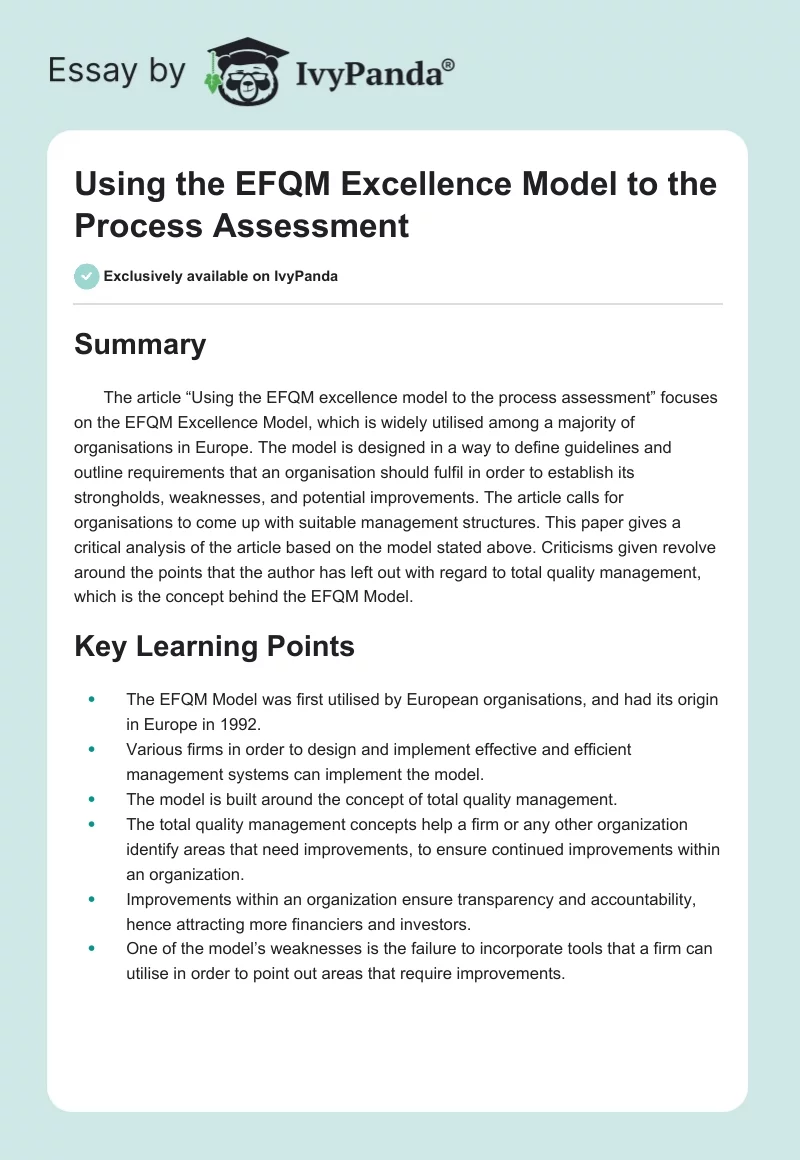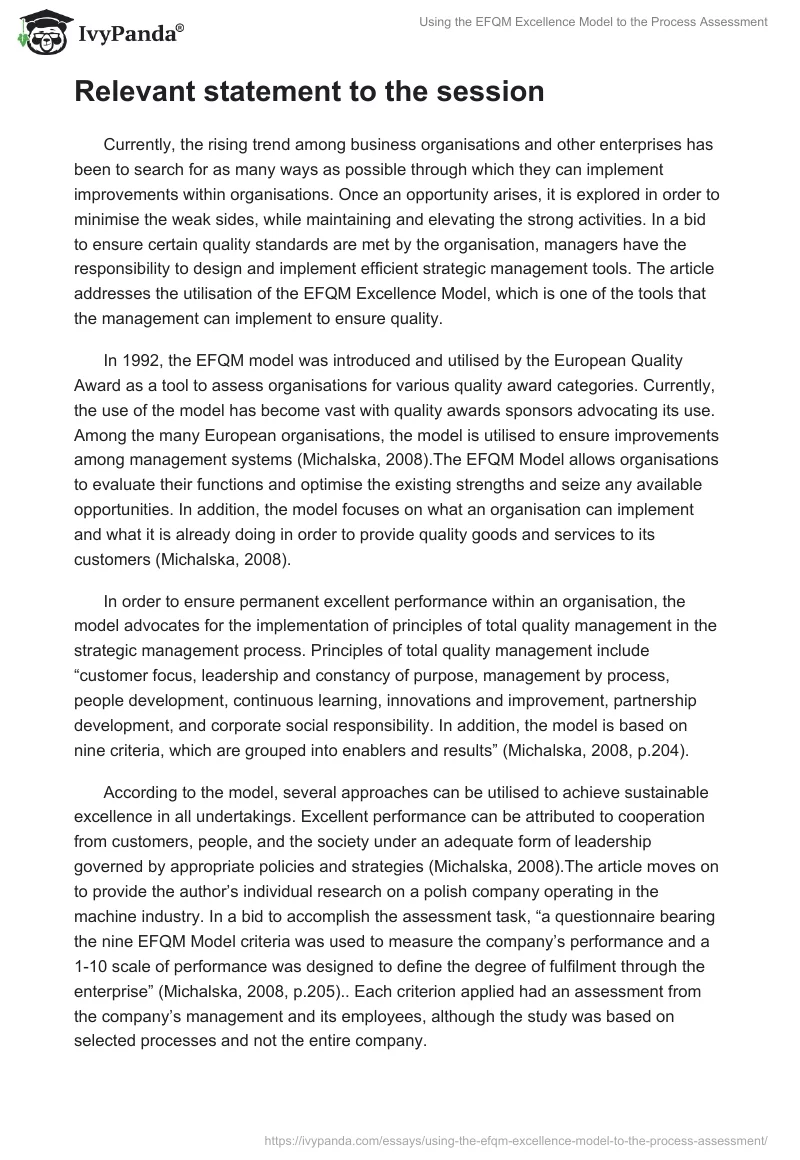Summary
The article “Using the EFQM excellence model to the process assessment” focuses on the EFQM Excellence Model, which is widely utilised among a majority of organisations in Europe. The model is designed in a way to define guidelines and outline requirements that an organisation should fulfil in order to establish its strongholds, weaknesses, and potential improvements. The article calls for organisations to come up with suitable management structures. This paper gives a critical analysis of the article based on the model stated above. Criticisms given revolve around the points that the author has left out with regard to total quality management, which is the concept behind the EFQM Model.
Key Learning Points
- The EFQM Model was first utilised by European organisations, and had its origin in Europe in 1992.
- Various firms in order to design and implement effective and efficient management systems can implement the model.
- The model is built around the concept of total quality management.
- The total quality management concepts help a firm or any other organization identify areas that need improvements, to ensure continued improvements within an organization.
- Improvements within an organization ensure transparency and accountability, hence attracting more financiers and investors.
- One of the model’s weaknesses is the failure to incorporate tools that a firm can utilise in order to point out areas that require improvements.
Relevant statement to the session
Currently, the rising trend among business organisations and other enterprises has been to search for as many ways as possible through which they can implement improvements within organisations. Once an opportunity arises, it is explored in order to minimise the weak sides, while maintaining and elevating the strong activities. In a bid to ensure certain quality standards are met by the organisation, managers have the responsibility to design and implement efficient strategic management tools. The article addresses the utilisation of the EFQM Excellence Model, which is one of the tools that the management can implement to ensure quality.
In 1992, the EFQM model was introduced and utilised by the European Quality Award as a tool to assess organisations for various quality award categories. Currently, the use of the model has become vast with quality awards sponsors advocating its use. Among the many European organisations, the model is utilised to ensure improvements among management systems (Michalska, 2008).The EFQM Model allows organisations to evaluate their functions and optimise the existing strengths and seize any available opportunities. In addition, the model focuses on what an organisation can implement and what it is already doing in order to provide quality goods and services to its customers (Michalska, 2008).
In order to ensure permanent excellent performance within an organisation, the model advocates for the implementation of principles of total quality management in the strategic management process. Principles of total quality management include “customer focus, leadership and constancy of purpose, management by process, people development, continuous learning, innovations and improvement, partnership development, and corporate social responsibility. In addition, the model is based on nine criteria, which are grouped into enablers and results” (Michalska, 2008, p.204).
According to the model, several approaches can be utilised to achieve sustainable excellence in all undertakings. Excellent performance can be attributed to cooperation from customers, people, and the society under an adequate form of leadership governed by appropriate policies and strategies (Michalska, 2008).The article moves on to provide the author’s individual research on a polish company operating in the machine industry. In a bid to accomplish the assessment task, “a questionnaire bearing the nine EFQM Model criteria was used to measure the company’s performance and a 1-10 scale of performance was designed to define the degree of fulfilment through the enterprise” (Michalska, 2008, p.205).. Each criterion applied had an assessment from the company’s management and its employees, although the study was based on selected processes and not the entire company.
Critical Analysis
Quality products entail provision of services and goods whose specification either meet or exceed requirements stipulated by customers. An organisation may find it quite difficult to establish customer requirements due to changes in tastes and preferences across different customers (Porter & Tanner, 2011). However, this aspect should not be an obstacle; rather, firms should establish a team to carry out a research on trends in the market to establish what customers want and what they do not need. Excellence within an organisation can only be achieved through continuous improvements, which will require an organisation to utilise various tools of quality management.
Firms and other enterprises can formulate a model that suites them best in order to ensure excellent performance not only on processes, but also on the overall performance of the entire organisation (Porter & Tanner, 2011). The article raises a discussion on the EFQM Excellent Model, whose idea originated from Europe, and has continued to be used by various companies in managing their quality. The EFQM Model stands to be reliable as it incorporates various tools and principles of total quality management. However, the model stipulates that guidelines and requirements that an organisation needs to follow in order to strengthen the management systems in place. The author needs to draw a clear definition of what a management system entails. Any company is entitled to a management system to manage its quality, regardless of the industry of venture or the size of the organisation. In addition, the model mainly advocates for the aspect of quality, which has been evidenced by the utilisation of the model by quality awards (Porter & Tanner, 2011).
However, quality does not only include improvements on processes and products, but also covers other aspects not covered in the article. For instance, total quality management calls for all employees of an organisation to work towards a common goal to the benefit of the organisation. In instances where a company incurs losses due to employee unfaithfulness, the actual output tends to deviate from the targets sets, hence a deviation from the set goals and objectives (Porter & Tanner, 2011). The management should come up with an adequate management system, with the help of an excellent but suitable model, to deal with such challenges. In fact, the award companies should also look at other aspects of the organisation other than the quality of output, when awarding companies because quality is a team journey, which can hardly be achieved without cooperation from all corners of the organisation.
As aforementioned, the EFQM Model allows organisations to evaluate their functions and optimise the existing strengths and seize any available opportunities. However, this point can be looked at as a weakness of the model as it fails to point out the actual problem that needs improvements. Although the model embraces the utilisation of various principles of total quality management, it fails to suggest some of the tools that a firm can utilise to identify problems within the organisation. Utilisation of tools such as checklists, Pareto analysis, and flowcharts among others are crucial in identifying the actual problem. This aspect makes it easier for the company to formulate and implement improvement measures.
Practical implications
The article relies largely on the concept of total quality management. In addition, the EFQM Model advocates for the utilisation of most of the concepts drawn from total quality management. Various firms and organisations in the UAE should implement the concept of total quality management in management systems in order to tap the benefits of total quality management as a concept (Michalska, 2008). For instance, total quality management defines the requirements of an efficient management system that can be helpful to firms experiencing various challenges within the management structure. In addition, total quality management is a tool of assessment that the firm utilises to evaluate its performance. Performance of an organisation largely depends on the output posted by all employees of the organisation. Individual performance contributes to the overall performance of an organisation; therefore, total quality management calls for the implementation of measures to ensure good performance.
The result-oriented criterion attracts attention towards an organisation, through which the organisation establishes a link between measures implemented and the results achieved (Michalska, 2008). Investors entrust their funds with the organisation whose performance is outstanding, since they are assured of getting it back and the interest earned. Total quality management identifies areas that need continued improvements. The concept can be beneficial to the organisation through helping to edge out competition because of continued improvements, hence better performance.
Learning Reflections
The EFQM model is useful in the determination of quality as it utilises various concepts of total quality management. Firms that utilise this model in their management systems emerge as quite competitive in the market. The EFQM model emphasizes the utilization of total quality management concepts in designing and implementation of a management system to be utilized within an organization. This aspect ensures continued improvements within the organization through identification of various loopholes and also suggests measures that could be implemented to curb the challenge. Through implementation of the EFQM model, accountability and transparency are promoted within the organization, hence boosting investor confidence in the organization.
Reference List
Michalska, J. (2008). Using the EFQM excellence model to the process assessment. Journal of Achievements in Materials and Manufacturing Engineering, 27(2), 203-06.
Porter, L., & Tanner, J. (2011). Assessing Business Excellence. Oxford, UK: Butterworth- Heinemann.


